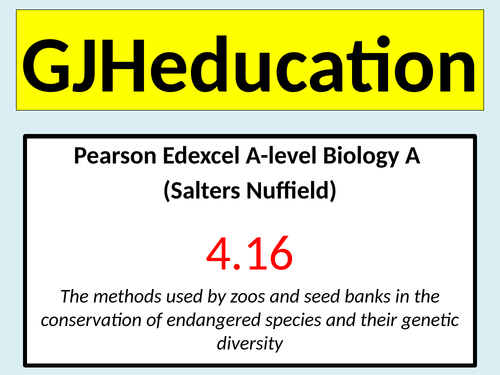







This lesson evaluates the methods used by zoos and seed banks in the conservation of endangered species. The PowerPoint and accompanying resources have been primarily designed to cover point 4.16 of the Pearson Edexcel A-level Biology A (Salters Nuffield) specification but as this is potentially the last lesson in this topic, lots of questions and activities have been included that will challenge the students on their knowledge of topic 4 (Biodiversity and Natural Resources).
Hours of research went into the planning of this lesson to source interesting examples to increase the relevance of the biological content and although the main focus of the lesson is the two ex situ conservation methods, the lesson begins with a consideration of the importance of the in situ methods that are used in the Lake Télé Community reserve in the Republic of Congo and the marine conservation zone in the waters surrounding Tristan da Cunha. Students will learn how this form of active management conserves habitats and species in their natural environment, with the aim of minimising human impact whilst maintaining biodiversity.
To enrich their understanding of ex situ conservation, the well-known examples of ZSL London zoo, Kew Gardens and the Millennium Seed Bank Project in Wakehurst are used. Students will understand how conserving animal species outside of their natural habitat allows for human intervention that ensures the animals are fed and given medical assistance when needed as well as reproductive assistance to increase the likelihood of the successful breeding of endangered species. An emphasis is placed on the desire to reintroduce the species into the wild and the example of some initial successes with the mountain chicken frog in Dominica and Montserrat is discussed. As stated in the specification point, these methods must be evaluated and therefore the issues are also considered and there is a focus on the susceptibility of captive populations to diseases as a result of their limited genetic diversity. The final part of the lesson considers how seed banks can be used to ensure that plant species, which may contain the molecules for medicine development, avoid extinction, and how the plants can be bred asexually to increase plant populations quickly.
Due to the extensiveness of this lesson, it is estimated that it will take in excess of 2/3 hours of allocated A-level teaching time to cover the tasks and content included in the lesson and as explained above, it can also be used as revision of topic 4 content
Something went wrong, please try again later.
This resource hasn't been reviewed yet
To ensure quality for our reviews, only customers who have purchased this resource can review it
Report this resourceto let us know if it violates our terms and conditions.
Our customer service team will review your report and will be in touch.